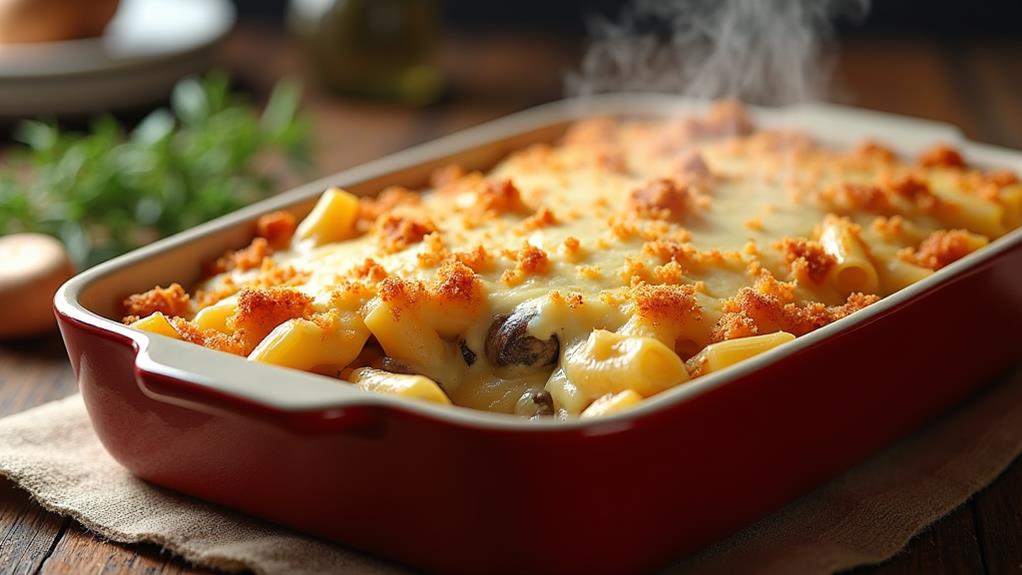You've likely encountered mushroom risotto before, but have you experienced the elevated version with fresh thyme? This classic Italian dish combines the earthy richness of mushrooms with the aromatic essence of thyme, creating a harmonious blend of flavors. As you consider preparing this comforting meal, you'll find that it's not just about the ingredients, but also the technique. The slow, methodical process of cooking risotto is as much a part of its charm as the final result. But what's the secret to achieving that perfect creamy consistency? And how can you ensure your mushrooms shine through?
Key Takeaways
- Mushroom risotto with thyme combines arborio rice, mixed mushrooms, vegetable broth, white wine, and fresh thyme for a creamy, flavorful dish.
- The cooking process involves sautéing mushrooms, coating rice, adding wine, gradually incorporating broth, and stirring in fresh thyme.
- Constant stirring and gradual broth addition are essential techniques for achieving the desired creamy texture.
- Thyme enhances the aroma while mushrooms contribute umami richness, creating a harmonious flavor profile.
- Serve immediately in a wide, shallow bowl, garnished with fresh thyme leaves for the best texture and presentation.
History
Risotto's origins can be traced back to northern Italy, where rice cultivation flourished in the Po Valley during the 14th century. As rice became more widely available, creative cooks began experimenting with new ways to prepare it. The technique of slowly cooking rice in broth, known as "risotto," emerged as a popular method that produced a creamy, flavorful dish.
You'll find that risotto quickly became a staple in Italian cuisine, with each region developing its own unique variations. The addition of mushrooms to risotto is believed to have originated in the forests of northern Italy, where various wild mushrooms grow abundantly. This combination of earthy mushrooms and creamy rice proved to be a match made in culinary heaven.
Over time, risotto has evolved and spread beyond Italy's borders, becoming a beloved dish worldwide. Today, you'll encounter countless variations of mushroom risotto, from simple recipes using common button mushrooms to more elaborate versions featuring exotic varieties like porcini or chanterelles.
The dish's enduring popularity is a testament to its delicious flavor and versatility.
Recipe
Mushroom risotto is a comforting and flavorful Italian dish that combines creamy arborio rice with earthy mushrooms. This simplified version uses just five ingredients to create a delicious meal that can be enjoyed any day of the week.
The key to a perfect risotto lies in the slow cooking process and constant stirring, which allows the rice to release its starches and create a creamy consistency without the need for cream or butter. The combination of mushrooms and thyme provides a rich, savory flavor that perfectly complements the rice, while the white wine adds depth and acidity to balance the dish.
- 1 1/2 cups arborio rice
- 8 oz mixed mushrooms, sliced
- 4 cups vegetable broth
- 1/2 cup dry white wine
- 1 tablespoon fresh thyme leaves
In a large pan, sauté the mushrooms until golden brown. Add the arborio rice and stir to coat the grains. Pour in the white wine and allow it to absorb before gradually adding the vegetable broth, one ladle at a time, stirring constantly.
Continue this process until the rice is creamy and cooked to al dente, about 18-20 minutes. Stir in the fresh thyme leaves just before serving.
For best results, use a variety of mushrooms to enhance the flavor profile of the dish. Keep the heat at medium-low throughout the cooking process to prevent the rice from sticking to the bottom of the pan.
If you prefer a looser consistency, add a little extra broth at the end of cooking. Remember that risotto continues to thicken as it cools, so serve it immediately for the best texture and flavor.
Cooking Steps
You'll start by sautéing the mushrooms until they're golden brown, then add the rice and coat it with the mushroom flavors.
Next, pour in the white wine and let it absorb before gradually adding vegetable broth, stirring constantly as each ladle is absorbed.
Step 1. Sauté Mushrooms Until Golden
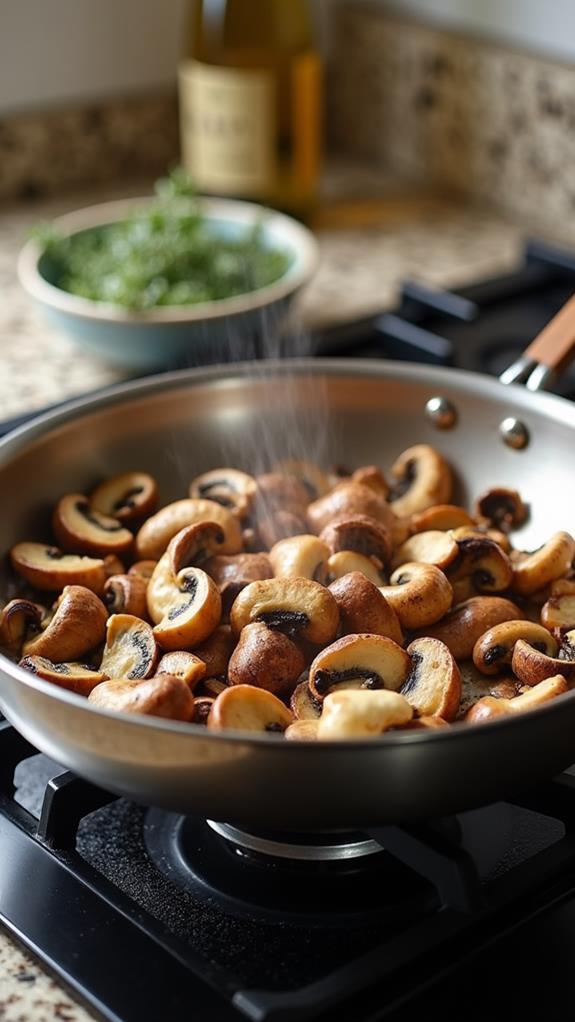
To begin the cooking process, heat a large pan over medium-high heat.
Once it's hot, add a drizzle of olive oil and swirl it around to coat the bottom.
Carefully add your sliced mushrooms to the pan, spreading them out in a single layer.
Don't overcrowd the pan; if necessary, cook the mushrooms in batches to ensure they brown properly.
Allow the mushrooms to cook undisturbed for about 3-4 minutes.
This will give them time to release their moisture and start to caramelize.
Once you see golden-brown edges forming, it's time to stir.
Use a wooden spoon or spatula to flip the mushrooms, exposing the uncooked sides to the heat.
Continue cooking for another 2-3 minutes, stirring occasionally, until the mushrooms are evenly golden and have reduced in size.
At this point, you'll notice a rich, earthy aroma filling your kitchen.
The mushrooms should be tender but not mushy, with a beautiful golden-brown color.
They're now ready to impart their deep, savory flavor to your risotto.
Step 2. Add Rice, Coat With Flavors

Once the mushrooms have reached their golden perfection, it's time to introduce the star of the show: the arborio rice. Add the rice to the pan with the mushrooms, stirring gently to coat each grain with the flavorful oils and juices released by the fungi.
You'll want to continue stirring for about two minutes, ensuring that every bit of rice is thoroughly coated and slightly toasted. This process is crucial as it helps the rice absorb the flavors more effectively and prepares it for the gradual addition of liquid.
As you stir, you'll notice the rice becoming slightly translucent around the edges while maintaining an opaque center. This visual cue indicates that the rice is ready for the next step.
Don't rush this process; the time you spend now will pay off in the final dish's depth of flavor. If you're using any aromatics like garlic or shallots, you can add them at this stage too. They'll infuse the rice with their essence, creating a more complex flavor profile in your risotto.
Step 3. Pour Wine, Allow Absorption
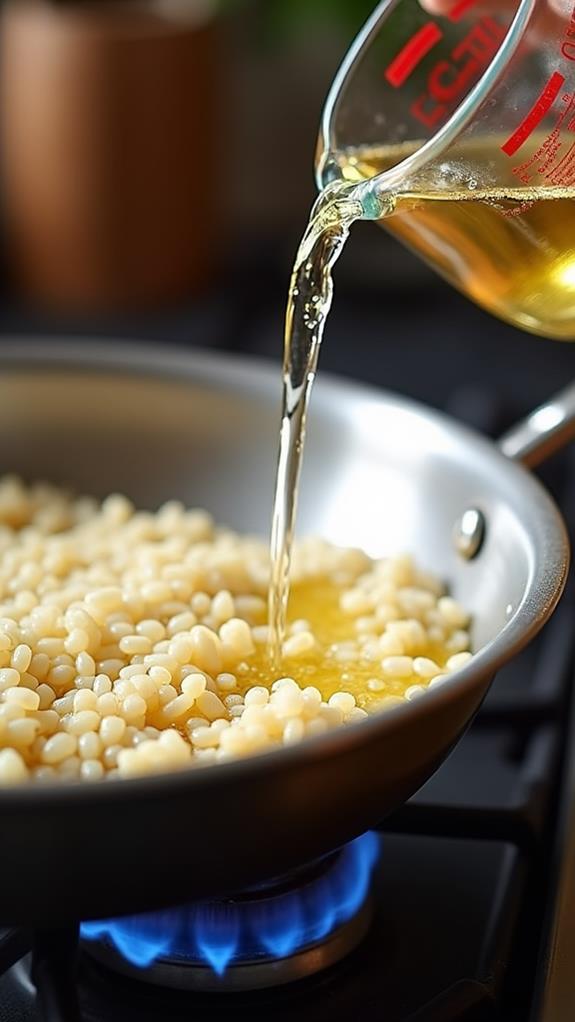
With the rice thoroughly coated, it's time to add a splash of white wine to the pan. Pour about 1/2 cup of dry white wine into the mixture, stirring gently to distribute it evenly.
You'll notice the wine will start to bubble and sizzle as it hits the hot pan. Keep stirring consistently, allowing the rice to absorb the wine's flavors and aromas.
As you continue to stir, you'll see the liquid gradually disappear. This process usually takes about 2-3 minutes. The wine isn't just for flavor; it also helps to tenderize the rice grains and adds a subtle acidity that balances the dish.
While the wine absorbs, you'll notice a fragrant aroma filling your kitchen – a promising sign of the delicious meal to come.
Once the wine has been almost completely absorbed, leaving the rice looking slightly glossy but not dry, you're ready for the next step.
It's crucial not to let the pan become too dry at this point, as it could cause the rice to stick and potentially burn. If needed, have your vegetable broth ready to begin the next phase of cooking.
Step 4. Gradually Add Vegetable Broth
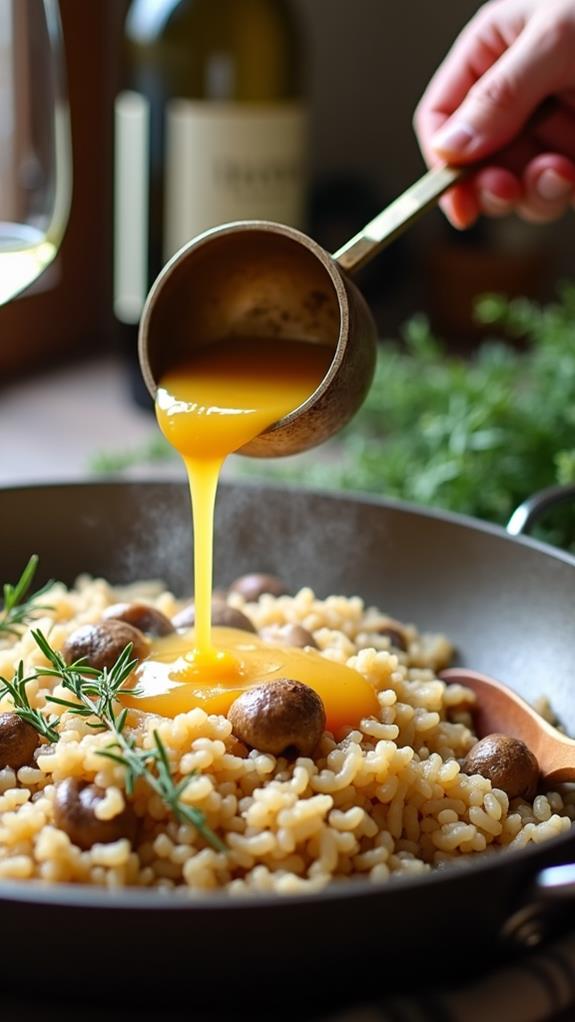
After the wine has been absorbed, it's time to begin the heart of the risotto-making process. Gradually adding vegetable broth is crucial for achieving the perfect creamy texture that defines a great risotto.
Start by having your warm vegetable broth ready in a separate pot nearby. Using a ladle, add about 1/2 cup of broth to the rice mixture, stirring constantly. As you stir, you'll notice the liquid being absorbed by the rice. Once the broth is nearly completely absorbed, it's time to add another ladleful.
Continue this process of adding broth and stirring until the rice is cooked to al dente, which means it should be tender but still have a slight firmness at the center. This process typically takes about 18-20 minutes.
As you near the end of cooking, taste the rice frequently to check its doneness. You may not need to use all the broth, or you might need to add a bit more if the rice isn't quite done.
The finished risotto should have a creamy, slightly loose consistency that slowly spreads when spooned onto a plate.
Step 5. Stir in Fresh Thyme
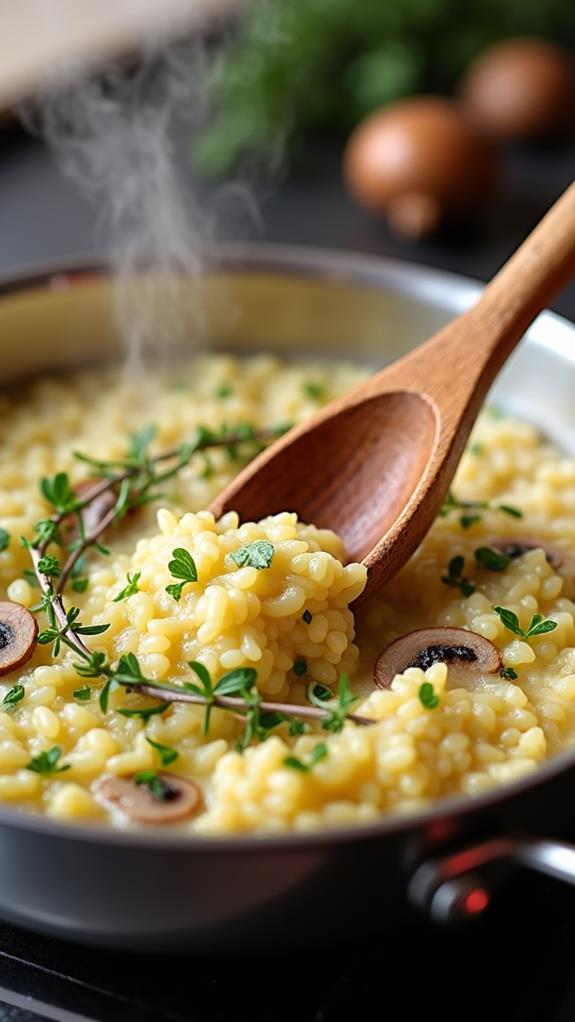
Just before serving your mushroom risotto, it's time to add the final touch of fresh thyme. This aromatic herb will elevate your dish, infusing it with a delicate, earthy flavor that complements the mushrooms perfectly.
To incorporate the thyme, remove the leaves from the stems by gently running your fingers along the stalk from top to bottom. You'll need about a tablespoon of fresh thyme leaves for a standard batch of risotto.
Sprinkle the thyme leaves over your creamy risotto and use a wooden spoon to gently fold them in. This action will distribute the herb evenly throughout the dish, ensuring every bite is infused with its distinct flavor.
As you stir, you'll notice the fragrant aroma of thyme mingling with the rich scent of mushrooms. Don't overcook the thyme, as it can become bitter; just a brief moment of heat is sufficient to release its oils.
Once incorporated, your mushroom risotto is ready to be plated and served immediately. The vibrant green specks of thyme won't only enhance the flavor but also add a visually appealing element to your dish.
Final Thoughts
This simplified mushroom risotto recipe proves that you don't need a long list of ingredients to create a delicious and satisfying meal.
With just five key components, you can whip up a restaurant-quality dish in the comfort of your own kitchen.
The combination of arborio rice, mushrooms, vegetable broth, white wine, and fresh thyme creates a harmonious blend of flavors and textures that'll impress even the most discerning palates.
[DIRECTIONS]:















